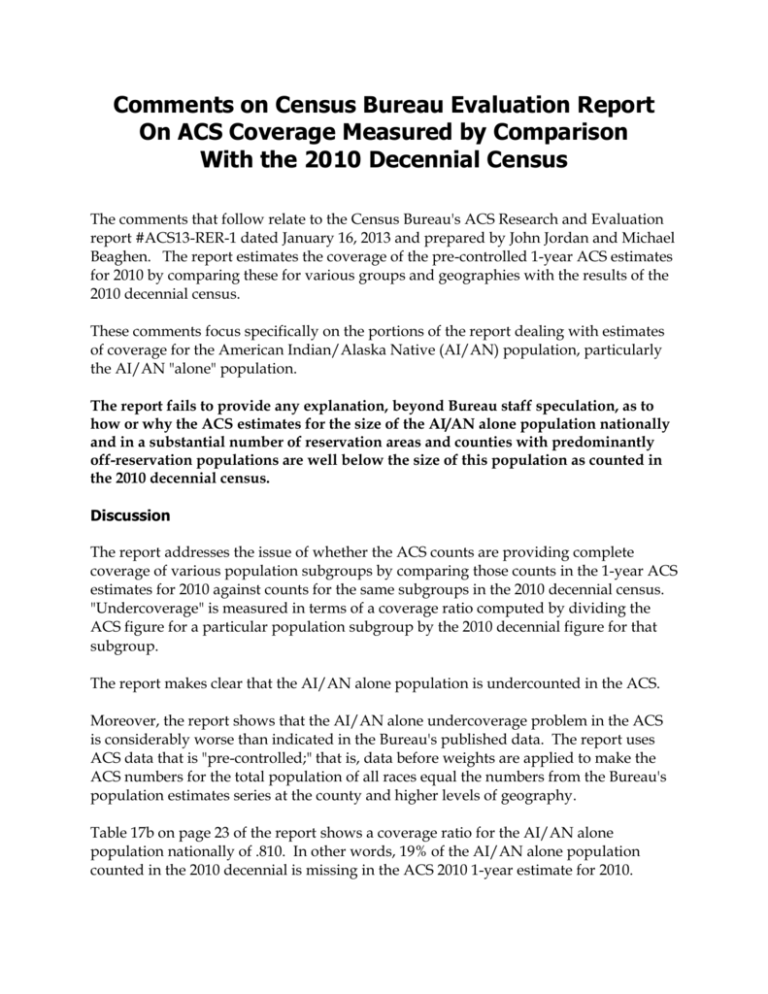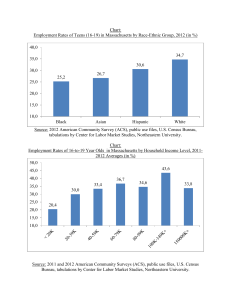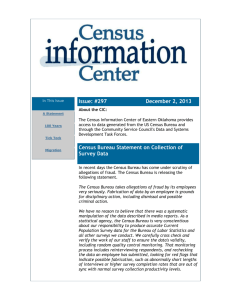Comments on Census Bureau Evaluation Report on ACS
advertisement

Comments on Census Bureau Evaluation Report On ACS Coverage Measured by Comparison With the 2010 Decennial Census The comments that follow relate to the Census Bureau's ACS Research and Evaluation report #ACS13-RER-1 dated January 16, 2013 and prepared by John Jordan and Michael Beaghen. The report estimates the coverage of the pre-controlled 1-year ACS estimates for 2010 by comparing these for various groups and geographies with the results of the 2010 decennial census. These comments focus specifically on the portions of the report dealing with estimates of coverage for the American Indian/Alaska Native (AI/AN) population, particularly the AI/AN "alone" population. The report fails to provide any explanation, beyond Bureau staff speculation, as to how or why the ACS estimates for the size of the AI/AN alone population nationally and in a substantial number of reservation areas and counties with predominantly off-reservation populations are well below the size of this population as counted in the 2010 decennial census. Discussion The report addresses the issue of whether the ACS counts are providing complete coverage of various population subgroups by comparing those counts in the 1-year ACS estimates for 2010 against counts for the same subgroups in the 2010 decennial census. "Undercoverage" is measured in terms of a coverage ratio computed by dividing the ACS figure for a particular population subgroup by the 2010 decennial figure for that subgroup. The report makes clear that the AI/AN alone population is undercounted in the ACS. Moreover, the report shows that the AI/AN alone undercoverage problem in the ACS is considerably worse than indicated in the Bureau's published data. The report uses ACS data that is "pre-controlled;" that is, data before weights are applied to make the ACS numbers for the total population of all races equal the numbers from the Bureau's population estimates series at the county and higher levels of geography. Table 17b on page 23 of the report shows a coverage ratio for the AI/AN alone population nationally of .810. In other words, 19% of the AI/AN alone population counted in the 2010 decennial is missing in the ACS 2010 1-year estimate for 2010. The published figures, which include the control adjustments, indicate that just 12.9% of the AI/AN alone population as counted in the decennial is missing in the ACS count. The overcounting of the AI/AN "in combination" population (those reporting as AI/AN multi-racial) tends to be roughly equivalent to the AI/AN alone undercount, resulting in a coverage ratio for the AI/AN alone or in combination population of .971, close to the coverage ratio for the White alone or in combination population. One result is a Census Bureau "preference" for using the AI/AN alone or in combination data, a preference expressed on page 8 of the report. The report seems to suggest that if the total AI/AN alone or in combination count in the ACS 1-year estimate for 2010 is close to the actual 2010 decennial count (it was within 3%), any undercount of the AI/AN alone population is of limited importance. The matching of the number of AI/AI alone persons undercounted with the number of AI/AN "in combination" (multi-racial) persons overcounted appears to lead Bureau staff to conclude that the alone undercount is explained by persons who switch from identifying as AI/AN alone in the decennial census to AI/AN multi-racial in the ACS. Without referring to the AI/AN situation specifically, the report says on page 11 "Importantly there were differences in coverage ratios of specific race groups that are likely attributable to differences in race reporting between the ACS and 2010 Census. Some estimates of coverage of race and ethnic groups were confounded by these phenomena and cannot be interpreted as measures of coverage." On page 23 the report asserts "We believe this difference is at least in part attributable to race reporting differences between the ACS and the 2010 Census." And on page 35 the report contends that "The differences seen between AIAN alone or in combination, AIAN alone, and AIAN in combination were most likely due to differences in how race was reported, a topic which merits further research." (Emphasis added.) A report published several months earlier puts the matter even more explicitly. It said "We believe that some of the individuals who reported a single race of non-Hispanic, AIAN Alone in Census 2000 (that is currently reflected in the PEP [Population Estimates Program]) are reporting two races in the ACS - the combination of non-Hispanic, AIAN and non-Hispanic, White."1 2012 American Community Survey Research and Evaluation Report Memorandum Series #ACS12-RER33, prepared by Deborah H. Griffin of the American Community Survey Office within the Census Bureau, dated November 29, 2012, page 4. 1 Comments on ACS Evaluation Report on Coverage Page 2 The Bureau has yet to publish any research based on an actual matching of a representative number of decennial and ACS questionnaires for the same persons at the national and selected local levels to substantiate this contention. In the section on page 59 on Future Research, the report notes "Clearly, there is more to understand about differences in race reporting between the ACS and the 2010 Census. A potential approach to measuring race reporting differences is to link ACS 1-year 2010 persons [sic] to the 2010 Census record and compare the race." Additional Comments Over the years I have found Census Bureau staff to be among the most responsive and friendly of any in the many federal agencies with which I have dealt. Nonetheless, the Bureau as an institution seems not to fully appreciate several aspects of the data on the Indian population that are important from a tribal perspective. The populations tabulated as AI/AN alone and AI/AN multi-racial are not equivalent in several important respects. Since the 2000 decennial census, the Bureau tabulates a person as AI/AN if they check the AI/AN box in response to the race question on a Census questionnaire. If the person does not check a box for any other racial category, the person is considered as an AI/AN alone person. If the person does check a box for another racial category, the person is considered as AI/AN "in combination with one or more other races." The sum of the two categories produces a count the Bureau labels as the AI/AN "alone or in combination" figure. All this information is collected through self-identification. Any person who says he or she is AI/AN is counted as AI/AN. Tribes and the basic law governing federal-tribal relations, PL 93-638, have a different standard of who's Indian. A person is Indian if that person is formally enrolled in an Indian tribe. The criteria for enrollment are determined by each tribe as an attribute of its sovereignty. The last publicly available figure for the total number of tribally-enrolled Indians2 in the US comes from a BIA report for 2005. That figure is 1,978,099. In contrast, the 2000 Census counted 2,475,956 AI/AN alone persons and 2,932,248 in the 2010 Census. If the BIA number is reliable, not all those self-identifying as AI/AN alone in the Census are enrolled tribal members. 2 The data covers only federally-recognized tribes, including those in Alaska. Comments on ACS Evaluation Report on Coverage Page 3 The inclusion of persons identifying as AI/AN multi-racial bring the total of the AI/AN alone or in combination population in 2000 to 4,119,301 and in 2010 to 5,220,579 -- far beyond any possible estimate of the total number of persons enrolled in Indian tribes. To the Census Bureau, Indian status is a matter of ancestry. To tribes, it's a matter of enrollment -- political status. That political status is the cornerstone of federal programs designed to exclusively serve Indian people. There is no test of Indian status in the Census. Tribes and most (but not all) federal programs providing services exclusively to Indians require proof of Indian status -- either enrollment or a Certificate of Degree of Indian Blood (CDIB). Though considerably larger, the Census Bureau's counts of the AI/AN alone population correspond more closely to the size of the Indian population from a tribal and federal perspective than do the Bureau's counts that include the AI/AN multiracial population. There are other important differences between the AI/AN alone and AI/AN multiracial populations. The AI/AN multi-racial population lives overwhelmingly in off-reservation areas. In 2010, only 1.3% of this population lived within federal reservation boundaries; 5.4% lived within the boundaries of former reservation areas in Oklahoma (OTSAs) and another .5% lived in Alaska Native villages. The remaining 92.8% lived outside the boundaries of any of these areas. Measured by poverty rates, an important indicator of well-being, the AI/AN alone and AI/AN multi-racial populations are quite different. According to the ACS data set for 2006 to 2010, the poverty rate for the AI/AN alone population in reservation areas was 36.8%; for the AI/AN alone population nationally it was 26.4%, but for the AI/AN multi-racial population nationally it was 19.7%. According to the Bureau's own statistics, the AI/AN alone and AI/AN multi-racial populations are not equivalent. The data published on the AI/AN alone or in combination population obscures the important differences between the two groups. All AI/AN areas are not equivalent. The Census Bureau has appropriately designated a variety of types of Native areas, recognizing the distinctions between areas that have legally assigned boundaries and those that don't and areas that have some type of federal status as distinct from those with only state status. The Bureau publishes a detailed description of the characteristics of each type of area, a description that is widely available. Of major help to data users, Comments on ACS Evaluation Report on Coverage Page 4 these areas are separated by having different series of code numbers that normally accompany the data tables. The demographic composition of the different types of what the Bureau terms "AI/AN Areas" varies dramatically. Federal reservation boundaries are strictly defined by law or Executive Order. Most, though not all, contain substantial concentrations of Indian people. Other types of areas have overwhelmingly non-AI/AN populations within boundaries that are partially self-selected by the groups identified with them. The economics are different. The socio-economic characteristics of the AI/AN populations tend to be different. Comparisons are appropriate within the various categories of AI/AN areas, not across them. However, Table 27 on page 40 of the report conflates these different types, showing data for just 3 federal reservations in a list of mixed AI/AN areas selected on the basis of the size of their total, not Indian, populations. This shows an obvious lack of understanding of Native geography. If the Census Bureau is to retain the respect of tribal leaders and tribal data users, it must demonstrate an understanding of these particular aspects of Native demography and Native geography in all its publications. Comments on ACS Evaluation Report on Coverage Page 5







